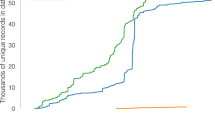Abstract
MRIQC is a quality control tool that predicts the binary rating (accept/exclude) that human experts would assign to T1-weighted MR images of the human brain. For such prediction, a random forests classifier performs on a vector of image quality metrics (IQMs) extracted from each image. Although MRIQC achieved an out-of-sample accuracy of \(\sim \)76%, we concluded that this performance on new, unseen datasets would likely improve after addressing two problems. First, we found that IQMs show “site-effects” since they are highly correlated with the acquisition center and imaging parameters. Second, the high inter-rater variability suggests the presence of annotation errors in the labels of both training and test data sets. Annotation errors may be accentuated by some preprocessing decisions. Here, we confirm the “site-effects” in our IQMs using t-student Stochastic Neighbour Embedding (t-SNE). We also improve by a \(\sim \)10% accuracy increment on the out-of-sample prediction of MRIQC by revising a label binarization step in MRIQC. Reliable and automated QC of MRI is in high demand for the increasingly large samples currently being acquired. We show here one iteration to improve the performance of MRIQC on this task, by investigating two challenging problems: site-effects and noise in the labels assigned by human experts.
Access this chapter
Tax calculation will be finalised at checkout
Purchases are for personal use only
Similar content being viewed by others
References
Power, J.D., Barnes, K.A., Snyder, A.Z., Schlaggar, B.L., Petersen, S.E.: Spurious but systematic correlations in functional connectivity MRI networks arise from subject motion. NeuroImage 59, 2142–2154 (2012). https://doi.org/10.1016/j.neuroimage.2011.10.018
Yendiki, A., Koldewyn, K., Kakunoori, S., Kanwisher, N., Fischl, B.: Spurious group differences due to head motion in a diffusion MRI study. NeuroImage 88, 79–90 (2014). https://doi.org/10.1016/j.neuroimage.2013.11.027
Reuter, M., et al.: Head motion during MRI acquisition reduces gray matter volume and thickness estimates. NeuroImage 107, 107–115 (2015). https://doi.org/10.1016/j.neuroimage.2014.12.006
Alexander-Bloch, A., et al.: Subtle in-scanner motion biases automated measurement of brain anatomy from in vivo MRI. Human Brain Mapping 37, 2385–2397 (2016). https://doi.org/10.1002/hbm.23180
Esteban, O., et al.: MRIQC: advancing the automatic prediction of image quality in MRI from unseen sites. PLOS ONE 12, e0184661 (2017). https://doi.org/10.1371/journal.pone.0184661
Di Martino, A., et al.: The autism brain imaging data exchange: towards a large-scale evaluation of the intrinsic brain architecture in autism. Mol. Psychiatry 19, 659–667 (2014). https://doi.org/10.1038/mp.2013.78
Poldrack, R.A., et al.: A phenome-wide examination of neural and cognitive function. Sci. Data 3, 160110 (2016). https://doi.org/10.1038/sdata.2016.110
Gorgolewski, K.J., Durnez, J., Poldrack, R.A.: Preprocessed consortium for neuropsychiatric phenomics dataset. F1000Research 6, 1262 (2017). https://doi.org/10.12688/f1000research.11964.2
Leek, J.T., et al.: Tackling the widespread and critical impact of batch effects in high-throughput data. Nature Rev. Genet. 11, 733–739 (2010). https://doi.org/10.1038/nrg2825
Woodard, J.P., Carley-Spencer, M.P.: No-Reference image quality metrics for structural MRI. Neuroinformatics 4, 243–262 (2006). https://doi.org/10.1385/NI:4:3:243
Mortamet, B., et al.: Automatic quality assessment in structural brain magnetic resonance imaging. Magn. Reson. Med. 62, 365–372 (2009). https://doi.org/10.1002/mrm.21992
Alfaro-Almagro, F., et al.: Image processing and Quality Control for the first 10,000 brain imaging datasets from UK Biobank. NeuroImage (2017). https://doi.org/10.1016/j.neuroimage.2017.10.034
Pizarro, R.A., et al.: Automated quality assessment of structural magnetic resonance brain images based on a supervised machine learning algorithm. Front. Neuroinformatics 10 (2016). https://doi.org/10.3389/fninf.2016.00052
Shehzad, Z., et al.: The Preprocessed Connectomes Project Quality Assessment Protocol - a resource for measuring the quality of MRI data. In Front. Neurosci. Conference Abstract: Neuroinformatics 2015, Cairns, Australia, 2015. https://doi.org/10.3389/conf.fnins.2015.91.00047
Pedregosa, F., et al.: Scikit-learn: machine learning in python. J. Mach. Learn. Res. 12, 2825–2830 (2011)
Author information
Authors and Affiliations
Corresponding author
Editor information
Editors and Affiliations
Rights and permissions
Copyright information
© 2018 Springer Nature Switzerland AG
About this paper
Cite this paper
Esteban, O., Poldrack, R.A., Gorgolewski, K.J. (2018). Improving Out-of-Sample Prediction of Quality of MRIQC. In: Stoyanov, D., et al. Intravascular Imaging and Computer Assisted Stenting and Large-Scale Annotation of Biomedical Data and Expert Label Synthesis. LABELS CVII STENT 2018 2018 2018. Lecture Notes in Computer Science(), vol 11043. Springer, Cham. https://doi.org/10.1007/978-3-030-01364-6_21
Download citation
DOI: https://doi.org/10.1007/978-3-030-01364-6_21
Published:
Publisher Name: Springer, Cham
Print ISBN: 978-3-030-01363-9
Online ISBN: 978-3-030-01364-6
eBook Packages: Computer ScienceComputer Science (R0)




